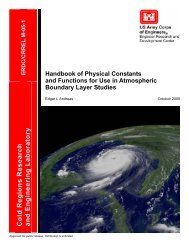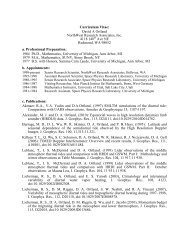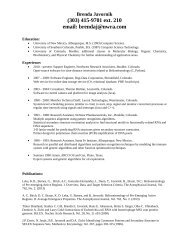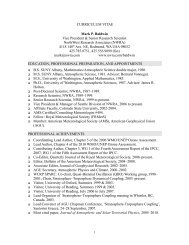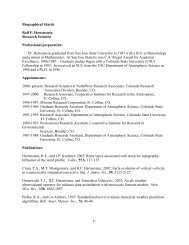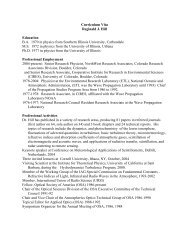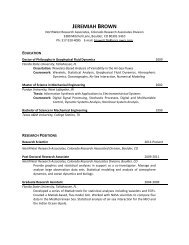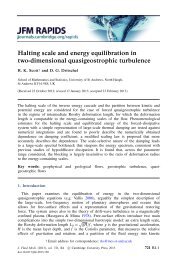Mark Hausman - NorthWest Research Associates, Inc.
Mark Hausman - NorthWest Research Associates, Inc.
Mark Hausman - NorthWest Research Associates, Inc.
You also want an ePaper? Increase the reach of your titles
YUMPU automatically turns print PDFs into web optimized ePapers that Google loves.
Dr. <strong>Mark</strong> A. <strong>Hausman</strong><br />
<strong>Research</strong> Scientist<br />
<strong>NorthWest</strong> <strong>Research</strong> <strong>Associates</strong><br />
301 Webster Street<br />
Monterey, CA 93940<br />
(831) 582-4903<br />
<strong>Mark</strong><strong>Hausman</strong>@nwra.com<br />
www.nwra.com<br />
Degrees:<br />
Ph.D. (Astrophysical Sciences) Princeton University, 1979<br />
M.S. (Astrophysical Sciences) Princeton University, 1977<br />
B.S. (with honors, Astronomy and Astrophysics) Michigan State University, 1975<br />
Dr. <strong>Hausman</strong>’s specialty is computer programs that model complex physical systems. He specializes in<br />
simulations and studies of ionospheric and space physics, and their effects on radar and communications<br />
systems. Fields of expertise include data translation (e.g., raw radar data from ROTHR and BMEWS) and<br />
data visualization. Dr. <strong>Hausman</strong> has created GUI’s (graphical user interfaces) and users’ guides to simplify<br />
user interaction with sophisticated applications. He is experienced in using Matlab and the FORTRAN 95,<br />
C, C++, Java, and Visual Basic programming languages.<br />
In September of 2005, Dr. <strong>Mark</strong> <strong>Hausman</strong> joined <strong>NorthWest</strong> <strong>Research</strong> <strong>Associates</strong> as a <strong>Research</strong> Scientist<br />
after twenty-one years at Mission <strong>Research</strong> Corporation. Currently, Dr. <strong>Hausman</strong> is working on a several<br />
projects to increase the accuracy and utility of OTH (over-the-horizon) radar for target tracking and radio<br />
direction-finding. These include the application and refinement to new and planned radar systems of<br />
CREDO techniques for ionospheric modeling, and the use of ray-tracing and ray-homing in altitudeestimation<br />
studies. He has also contributed to HiCIRF, a software HF channel simulator that simulates OTH<br />
radar propagation at the antenna element level.<br />
Dr. <strong>Hausman</strong> has been working in support of the GPSII program, a method to derive accurate models of the<br />
earth’s ionosphere using timing measurements collected from GPS satellites. The program was originally<br />
created to study the correlation of earthquakes with ionospheric precursors, but has much wider utility that is<br />
currently being developed. He has also contributed to the SIFTER effort, a signal-processing algorithm that<br />
enhances detection of weak targets by OTH and surface-wave radars. He has been involved in developing<br />
techniques to mitigate various ionospheric effects, such as Traveling Ionospheric Disturbances (TIDs),<br />
ionospheric Doppler shifts, and impulsive noise. The MINER algorithm (Meteor and Impulsive Noise<br />
Excision by Regression) has already been delivered as a stand-alone program. Additionally, Dr. <strong>Hausman</strong><br />
has created the “RunSifter” GUI and “watch_sifter” Matlab scripts to improve SIFTER’s ease-of-use.<br />
From 1995, Dr. <strong>Hausman</strong> has worked on the CREDO and APMA programs, which aim to improve the<br />
accuracy of the Navy’s Relocatable Over-The Horizon Radar (ROTHR). He wrote a computer program that<br />
extracts raw data from ROTHR tape files and translates it into forms accessible to UNIX and Windows<br />
computers. He helped develop computer tools that use available ionogram sounding data to specify current<br />
ionospheric conditions, which are then used to create Coordinate Registration (CR) tables that translate a<br />
target’s delay into ground range. A notable achievement was the “Ionoview” program, a Graphical User<br />
Interface (GUI) running on ordinary Windows PC’s that helps visualize ionogram data and provides a<br />
control center to other CREDO analysis programs.
In 1994 and 1995, Dr. <strong>Hausman</strong> helped to refine and evaluate the PROPMOD computer code, which<br />
predicts the effects of ionospheric structure on satellite communications and trans-ionospheric radar<br />
propagation. From time to time since, he has updated PROPMOD with newer versions of its component<br />
models, including the addition in February 2002 of version 14.03 of WBMOD. A number of specialpurpose<br />
modifications allow the creation of contour maps showing disturbance over broad geographic<br />
regions, the prediction of TEC (total electron content) statistics, and databases showing the probability of<br />
achieving specified performance criteria. In 2003, he updated the distributed form of PROPMOD to a<br />
subroutine that users may optionally link into their own applications. In 2001 and 2003 PROPMOD was<br />
used in support of the MUOS effort, supplying global databases of predicted ionospheric scintillation.<br />
From 1998 to 2002, Dr <strong>Hausman</strong> worked on the RNECS project, with particular attention to improving the<br />
ionospheric corrections used in the BMEWS radar processing algorithms. One aspect of this work was a<br />
series of routines translating BMEWS data from raw 60-bit CDC LRIDs into files readable by modern<br />
desktop programs (such as Matlab).<br />
In 1999, Dr. <strong>Hausman</strong> wrote a series of Test Suites and Users’ Guides for some of the DTRA codes being<br />
delivered to the LIDS program. He has also developed a simple computer model of the x-ray ionization<br />
patch created by a high-altitude nuclear burst, suitable for inclusion in an engagement-level simulation code.<br />
While developing and testing this model, he has become familiar with the use of NORSE and ASSIST for<br />
generating disturbed ionospheres. In 2000, Dr. <strong>Hausman</strong> did extensive comparisons of his fast<br />
XRAYPATCH code to the DTRA standard programs WEDCOM and NORSE, which revealed not only the<br />
desirability of further work with XRAYPATCH, but also several differences between the predictions of<br />
WEDCOM and NORSE. Dr. <strong>Hausman</strong> has also served as a beta-tester for ASSIST.<br />
From January 1984, until 1994, Dr. <strong>Hausman</strong>’s work at Mission <strong>Research</strong> Corporation was concerned with<br />
the physics of nuclear bursts at high altitudes. In 1994, he worked with Dr. Bernard Roth to help develop the<br />
DGBETS computer code, a fast-running routine encapsulating the Defense Threat Reduction Agency’s<br />
model for debris deposition from high altitude bursts. DGBETS is intended for incorporation into the<br />
engagement-level simulations used by DTRA customers, and has been incorporated into the ASSIST suite.<br />
From 1987 until 1993, Dr. <strong>Hausman</strong>’s principle concern was the CMHD computer code; this code calculates<br />
in detail the energy partition and deposition that occurs in the first few seconds following a high altitude<br />
nuclear explosion. Dr. <strong>Hausman</strong> helped to update the CMHD code, adding three-dimensional capability and<br />
extending the modeled region to lower altitudes. The CMHD code has been used to model bursts at a<br />
number of altitudes from 150 km up; the simulation results have been used to model kinetic energy<br />
deposition and radioactive debris distribution in the Northern Conjugate Region.<br />
In connection with the CMHD program, Dr. <strong>Hausman</strong> developed an interactive computer program that<br />
synthesized two-dimensional isophote maps of any desired three-dimensional distribution of volume<br />
emission. The program was used to make synthetic images of the deposition patches predicted by CMHD<br />
models of the STARFISH event; these were compared to actual STARFISH data as a check on the accuracy<br />
of the models.<br />
From 1984 to 1987, Dr. <strong>Hausman</strong> used another computer simulation program to examine the Naval<br />
<strong>Research</strong> Laboratory’s laser/plasma experiments, which were designed to simulate high altitude bursts.<br />
Specific concerns were the collisional coupling of expanding debris with the surrounding air and the use of<br />
distortions in applied magnetic fields to trace the locations of debris. He also investigated the possible onset<br />
of plasma instabilities and fast magnetic pulses in the low-beta regime of the NRL experiments.<br />
Dr. <strong>Hausman</strong> has also served as a research associate in theoretical astrophysics at the Universities of Texas<br />
and Virginia. At Texas his research concentrated upon the interstellar medium and the dynamics and<br />
structure of galaxies. His statistical model for the mass spectrum and velocity distribution function of<br />
interstellar clouds revealed shortcomings in the standard, collisional theory of cloud growth. He also studied<br />
the effects of both gravitational and collisional encounters upon the evolution of giant molecular clouds in
the galaxy and demonstrated a dissipationless model for the growth of very large-scale, “frothy” structure in<br />
the universe. At the University of Virginia, he used computer models to study the response of a cloudy<br />
interstellar medium to the gravitational potentials of spiral galaxies. There he also helped develop a<br />
computer model designed to simulate the marginally collisional flow of gas in the rarefied interior of a gas<br />
centrifuge.<br />
While a National Science Foundation Graduate Fellow at Princeton University, he developed a threedimensional<br />
hydrodynamics code, which he used to simulate the collisions of self-gravitating interstellar gas<br />
clouds. At Princeton, he also engaged in research on the structure of globular star clusters, the effects of<br />
terrestrial atmospheric fluctuations on solar observations, and the structural evolution of “cannibal” galaxies,<br />
which grow by engulfing their neighbors.<br />
Dr. <strong>Hausman</strong>’s major publications and reports include the following:<br />
“A wideband channel probe for space situational awareness,” 2013 Beacon Satellite Symposium, Bath, UK,<br />
July 8-10, 2013 (with D. L. Knepp and C. M. Spooner).<br />
“HiCIRF: A High-Fidelity HF Channel Simulation,” Radio Science, V.47, RS0L11,<br />
doi:10.1029/2011RS004928, 2012 (with L J. Nickisch, Gavin St. John S. V. Fridman, and C. J. Coleman).<br />
“Inversion of Backscatter Ionograms and TEC Data for Over-the-Horizon Radar,” Radio Sci., 47,<br />
doi:10.1029/2011RS004932, 2012 (with L J. Nickisch and S. V. Fridman).<br />
“Real time reconstruction of the three-dimensional ionosphere using data from diverse sources with IRI as a<br />
background model,” with S. V. Fridman and L. J. Nickisch, Real-Time International Reference Ionosphere<br />
Workshop, Colorado Springs, USA, May 4-6, 2009<br />
“GPSII User’s Guide”, February 2009 (unpublished electronic document).<br />
“PC-based system for real time reconstruction of the three-dimensional ionosphere using data from diverse<br />
sources,” with S. V. Fridman and L. J. Nickisch, Radio Science, submitted October 2008.<br />
“PC-based system for real time reconstruction of the three-dimensional ionosphere using data from diverse<br />
sources,” with S. V. Fridman and L. J. Nickisch, XXIX General Assembly of the International Union of<br />
Radio Science, Chicago, Illinois, USA, August 7-16, 2008, Paper G04.a4<br />
“PC-based system for real time reconstruction of the three-dimensional ionosphere using data from diverse<br />
sources,” with S. V. Fridman and L. J. Nickisch, 12 th International Ionospheric Effects Symposium<br />
Proceedings, Alexandria, VA, 2008, P. 415-426<br />
“SIFTER for ROTHR Users Guide”, with S. V. Fridman and L. J. Nickisch, <strong>NorthWest</strong> <strong>Research</strong><br />
<strong>Associates</strong>, NWRA-BELL-07-R350, Revised March 2008.<br />
“Traveling Ionospheric Disturbance Mitigation for OTH Radar,” Proceedings IEEE Radar 2007 Conference,<br />
2007 (with L. J. Nickisch and Sergey Fridman, invited paper).<br />
“Ionospheric Effects Mitigation for Radar Systems Using GPS Ionospheric Inversion (GPSII),” AFRL<br />
Technical Report AFRL-VS-HA-TR-2007-1064, 1 December 2006 (with L. J. Nickisch, Sergey V. Fridman,<br />
and James A. Secan).<br />
“Ionospheric Effects Mitigation for Radar Systems Using GPS Ionospheric Inversion (GPSII),” AFRL<br />
Technical Report AFRL-VS-HA-TR-2007-1064, 1 December 2006 (with L. J. Nickisch, Sergey V. Fridman,<br />
and James A. Secan).<br />
“Tests of SIFTER for CODAR with Tracker,” with S. V. Fridman and L. J. Nickisch, Final Technical<br />
Report, NWRA-Bell-06-R338, August 2006.<br />
“SIFTER for CODAR,” with S. V. Fridman and L. J. Nickisch, Final Technical Report, NWRA-Bell-06-<br />
R322, May 2006.
“TID Mitigation for OTH Radar and High-Fidelity HF Propagation Modeling,” with L. J. Nickisch and S. V.<br />
Fridman, Final Technical Report, NWRA-BELL-06-R318, March 2006.<br />
“Real-time reconstruction of the three-dimensional ionosphere using data from a network of GPS receivers,”<br />
with S. V. Fridman, L. J. Nickisch, and <strong>Mark</strong> Aiello, Radio Sci., 41, RS5S12, doi:10.1029/2005RS003341,<br />
2006.<br />
“Range rate–Doppler correlation for HF propagation in traveling ionospheric disturbance environments,”<br />
with L. J. Nickisch, and S. V. Fridman, Radio Sci., 41, RS5S39, doi:10.1029/2005RS003358, 2006.<br />
“OTH Radar Propagation Analysis,” with Sergey V. Fridman, Kevin Collins, <strong>Mark</strong> Aiello, and L. J.<br />
Nickisch, Mission <strong>Research</strong> Corporation report MRC/MRY-R-119, July 2005.<br />
“Earthquake Remote Precursor Sensing by Inversion of GPS Two-Frequency Beacon Data,” with Sergey V.<br />
Fridman, L. J. Nickisch, and <strong>Mark</strong> Aiello, Mission <strong>Research</strong> Corporation report MRC/MRY-R-118, May<br />
2005<br />
“Traveling Ionospheric Disturbance Effects and Modeling for Over-the-Horizon Radar,” with L. J. Nickisch<br />
and Sergey V. Fridman, Mission <strong>Research</strong> Corporation report MRC/MRY-R-117, April 2004.<br />
“The MINER Algorithm for Impulsive Noise Excision from ROTHR Data”, with L. J. Nickisch and S. V.<br />
Fridman, Mission <strong>Research</strong> Corporation, MRC/MRY-R-115, September 2003.<br />
“The PROPMOD Subroutine: A Flexible Tool for Computing Propagation and TEC Parameters,” with L. J.<br />
Nickisch and D. L. Knepp, Mission <strong>Research</strong> Corporation, MRC/MRY-R-113, June 2003.<br />
“SIFTER Users Guide”, with S. V. Fridman and L. J. Nickisch, Mission <strong>Research</strong> Corporation, MRC/MRY-<br />
R-112, July 2003.<br />
“SIFTER: Signal Inversion For Target Extraction and Registration—Coherent Processing of IQ Data”, with<br />
L. J. Nickisch and S. V. Fridman, Mission <strong>Research</strong> Corporation, MRC/MRY-R-111, July 2003.<br />
“The PROPMOD Subroutine: Propagation Parameters and a TEC Model,” with L. J. Nickisch and D. L.<br />
Knepp, Mission <strong>Research</strong> Corporation, MRC/MRY-R-106, May 2002.<br />
“CREDO User’s Guide”, with L. J. Nickisch and S. V. Fridman, Mission <strong>Research</strong> Corporation,<br />
MRC/MRY-R-105, July 2002.<br />
“Polar region ionospheric effects on UHF radar track acquisition”, Radio Science, 36, Number 5, 1157, with<br />
J. T. Reinking and D. L. Knepp, September/October 2001.<br />
“SIFTER: Signal Inversion For Target Extraction and Registration—Proof of Concept”, with L. J. Nickisch<br />
and S. V. Fridman, Mission <strong>Research</strong> Corporation, MRC/MRY-R-099, July 2001.<br />
“CIT Assisted Coordinate Registration for OTH Radar”, with S. V. Fridman and L. J. Nickisch, Mission<br />
<strong>Research</strong> Corporation, MRC/MRY-R-088, July 2000.<br />
“Comparison of the ‘XRAYPATCH’ Model to WEDCOM and NORSE,”, Mission <strong>Research</strong> Corporation,<br />
MRC/MRY-R-087, June 2000.<br />
“DGBETS Users’ Guide and Test Suite: a Fast Routine for Debris Gamma and Beta Environments,” with B.<br />
Roth, Mission <strong>Research</strong> Corporation, MRC/MRY-R-083, November 1999.<br />
“PROPMOD User’s Guide and Test Suite: Computing Transionospheric Radio Propagation Parameters,”<br />
with L. J. Nickisch and D. Knepp, Mission <strong>Research</strong> Corporation, MRC/MRY-R-082, October 1999<br />
(revised October 2001).<br />
“The Effects of Prompt Ionization on UHF Radar—A Fast-Running Model,” Mission <strong>Research</strong> Corporation,<br />
MRC/MRY-R-075, May 1999.
“APMA User’s Guide,” with L. J. Nickisch and S. Fridman, Rome Laboratory Software Documentation,<br />
Contract F30602-9C-C-0259, Mission <strong>Research</strong> Corporation, MRC/MRY-R-071, August 1998.<br />
“Automated Propagation Management and Assessment for Over-the-Horizon Radar—Final Technical<br />
Report,” with L. J. Nickisch and S. Fridman, Rome Laboratory Final Technical Report, Contract F30602-<br />
9C-C-0259, Mission <strong>Research</strong> Corporation, MRC/MRY-R-070, August 1998.<br />
“Automated Propagation Management and Assessment for Over-the-Horizon Radar— Interim Technical<br />
Report,” with L. J. Nickisch and S. Fridman, Rome Laboratory Interim Technical Report, Contract F30602-<br />
9C-C-0259, Mission <strong>Research</strong> Corporation, MRC/MRY-R-067, March 1998.<br />
“DGBETS (Debris Gamma and Beta Environments for Tactical Systems), version 2.0—Users Guide and<br />
Technical Manual”, with B. Roth, MRC-R-1490, December 1996.<br />
“CREDO: Coordinate Registration Enhancement by Dynamic Optimization—Final Development and<br />
Implementation,” with L. J. Nickisch, Rome Laboratory Final Technical Report, Contract F30602-93-C-<br />
0115, Mission <strong>Research</strong> Corporation, MRC/MRY-R-048R, March 1996.<br />
“Software User’s Manual for CREDO,” with L. J. Nickisch, Rome Laboratory Software User’s Manual,<br />
Contract F30602-93-C-0115, Mission <strong>Research</strong> Corporation, MRC/MRY-R-047, March 1996.<br />
“CREDO: Coordinate Registration Enhancement by Dynamic Optimization—Demonstration/Validation,”<br />
with L. J. Nickisch, Rome Laboratory Interim Technical Report, Contract F30602-93-C-0115, Mission<br />
<strong>Research</strong> Corporation, MRC/MRY-R-046, December 1995.<br />
“Software Design Document for CREDO,” with L. J. Nickisch, Rome Laboratory Software Design<br />
Document, Contract F30602-93-C-0115, Mission <strong>Research</strong> Corporation, MRC/MRY-R-045, March 1996<br />
(Revision 2).<br />
“PROPMOD—A Program for Computing Propagation Effects on Transionospheric Radio Signals (Volumes<br />
1 and 2),” with D. E. Knepp and L. J. Nickisch, Phillips Laboratory PL-TR-95-2120, Mission <strong>Research</strong><br />
Corporation, MRC/MRY-R-052, August 1995.<br />
“CREDO: Coordinate Registration Enhancement by Dynamic Optimization—Proof of Concept,” with L. J.<br />
Nickisch, G. K. Yeung, and J. R. Akin, Rome Laboratory Interim Technical Report, Contract F30602-93-C-<br />
0115, Mission <strong>Research</strong> Corporation, MRC/MRY-R-041, July 1995.<br />
“3D-CMHD Simulation of 200 KT at 150 km. Volume 1—Summary of Magnetic Bubble, Debris, Ion Patch<br />
and UV Results (U)”, DNA-TR-94-15-V1 (S-RD), with R. Kilb, September 1994.<br />
“3D-CMHD Simulation of 200 KT at 150 km. Volume 2—Detailed Graphical Results (U)”, DNA-TR-94-<br />
15-V2 (U), with R. Kilb, September 1994.<br />
“3D-CMHD Simulation of 200 KT at 200 km. Volume 1—Summary of Magnetic Bubble, Debris, Ion Patch<br />
and UV Results (U)”, DNA-TR-93-152-V1 (MRC-R-1450-V1) (S-RD), with R. Kilb, March 1994.<br />
“3D-CMHD Simulation of 200 KT at 200 km. Volume 2—Detailed Graphical Results (U)”, DNA-TR-93-<br />
152-V2 (MRC-R-1450-V2) (U), with R. Kilb, March 1994.<br />
“Debris Deposition Following a 200 km Burst (U)”, paper for 1993 DNA Symposium on Atmospheric<br />
Nuclear Effects (U), September 1993.<br />
“3D-CMHD Simulation of 1 MT at 300 km. Volume 1—Summary of Results and Ion Patch Depositions<br />
(U)”, DNA-TR-92-197-V1 (MRC-R-1429-V1) (S-RD), with R. Kilb, 1992.<br />
“3D-CMHD Simulation of 1 MT at 300 km. Volume 2—Detailed Graphical Results (U)”, DNA-TR-92-197-<br />
V2 (MRC-R-1429-V2) (U), with R. Kilb, 1992.<br />
“Early-Time Simulation of a 300 km Burst (U)”, paper for 1992 DNA Symposium on Atmospheric Nuclear<br />
Effects (U), September 1992.
“STARFISH. Volume 1—Main Report and Appendix A for 3D-CMHD Fine-Grid Results (U)”, DNA-TR-<br />
91-174-V1 (MRC-R-1351-V1) (S-RD), with D. Terry and R. Kilb, 1991.<br />
“STARFISH. Volume 2—Appendix B for 3D-CMHD Fine-Grid Results (U)”, DNA-TR-91-174-V2 (MRC-<br />
R-1351-V2) (U), with D. Terry and R. Kilb, 1991.<br />
“Evolution of the Starfish Burst Region and Energy Deposition Patch: CMHD Coarse-Grid Simulation (U)”,<br />
DNA-TR-89-286 (MRC-R-1269) (S-RD), with D. Terry and R. Kilb, 1989.<br />
“Starfish 3D-CMHD Coarse-Grid Results (U)”, DNA-TR-88-193 (MRC-R-1175 (U)), with D. Terry and R.<br />
Kilb, 1988.<br />
“1986 DNA Atmospheric Nuclear Effects Summer Study. Volume IV—Early-Time Phenomenology (0 to<br />
1 s) (U)”, DNA-TR-87-181-V4 (C), with B. Ripin and W. Chesnut, et al., 1987<br />
“Magnetic Field Compression and Evolution in Laser- Produced Plasma Expansions (U),” Phys. Fluids, 29,<br />
2007, with S. Kacenjar, et al. 1986.<br />
“Three Dimensional, Stratified Gas Flows Past an Obstacle,” J. Comp. Phys., 55, 347, with W. W. Roberts,<br />
1984.<br />
“Spiral Structure and Star Formation,” (parts I and II), Astrophys. J., 277, 744 and 282, 106, with W. W.<br />
Roberts, 1984.<br />
“The Evolution of Voids in the Expanding Universe,” Astrophys. J., 270 351, with D. W. Olson and B. D.<br />
Roth, 1983.<br />
“Theoretical Models of the Mass Spectrum of Interstellar Clouds,” Astrophys. J., 261, 532, 1982.<br />
“A Turbulent Model for Giant Molecular Clouds,” Astrophys. J., 245, 92, with F. Bash and J. Papaloizou,<br />
1981.<br />
“Collisional Mergers and Fragmentation of Interstellar Clouds,” Astrophys. J., 245, 72, 1981.<br />
“Galactic Cannibalism,” Mercury, 8, 119, 1979.<br />
“Galactic Cannibalism. III. The Morphological Evolution of Galaxies and Clusters,” Astrophys. J., 224, 320,<br />
with J. P. Ostriker, 1978.<br />
“Apparent Solar Oscillations and Fluctuations in the Earth’s Atmosphere,” Astron. and Astrophys., 59, 279,<br />
with E. Fossat, J. Harvey, and C. Slaughter, 1977.<br />
“Optical Structure of the X-Ray Globular Clusters NGC 6440 and NGC 6441,” Astrophys. J., 207, L181,<br />
with N. A. Bahcall, 1976.


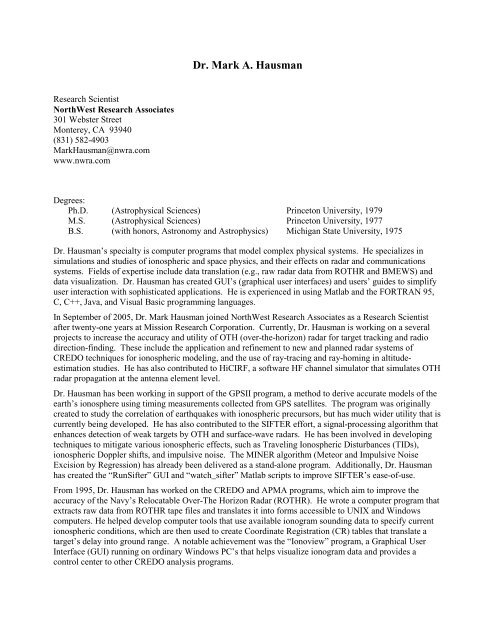
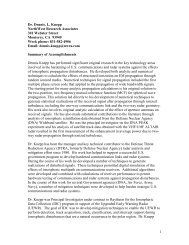

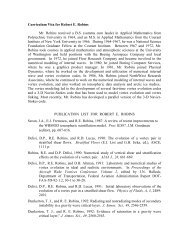
![Visa Waiver Program [pdf]](https://img.yumpu.com/24841919/1/190x245/visa-waiver-program-pdf.jpg?quality=85)
